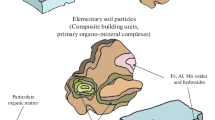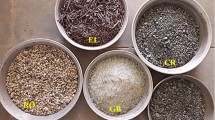Abstract
The grain size distribution of soils is known to be an important parameter in providing initial understanding for the physical and mechanical behavior of soils in many engineering geology applications. Therefore, the literature contains many grain size-based approaches, indices, or empirical models to describe soil for classification purposes or predict soil behavior under static and/or dynamic loading conditions. Because of the absence at present of a convenient single parameter that defines an entire grain size distribution curve, mean, median, standard deviation, the coefficients of uniformity and curvature, fines content, effective particle size etc., are currently used to describe the general slope and shape of the grain size distribution curve in engineering geological studies. In order to overcome with this limitation, comprehensive research has been performed in which an appropriate new parameter to represent grain size distribution curves is defined. Accordingly “grain size index (I GS)” is then used in a soil classification system and empirical models to predict physical and mechanical properties of soils. Statistical analyses were performed to prove its validity and to test its applicability for prediction of soil physical and mechanical properties. In addition to the availability of the I GS for soil classification and preliminary assessment of liquefaction properties of soil, it can also be used to estimate the swelling characteristics of expansive soils.








Similar content being viewed by others
References
Abbasoglu C (1971) Ion exchange process affecting swelling and other properties of Ankara clay. MSc. Thesis, METU, Civil Engineering Department, p 78
Al-Homoud AS, Al-Suleiman TI (1997) Loss in serviceability of pavements due to expansive clay subgrades. Environ Eng Geosci III(1):277–294
Al-Mhaidib AI (2006) Swelling behavior of expansive shale: a case study from Saudi Arabia. In: Al-Rawas AA, Goosen MFA (eds) Expansive soils: recent advances in characterization and treatment. Taylor and Francis––AA Balkema Publishers, The Netherlands, pp 273–287
ASTM D4546-90 (1996) Standard test methods for one-dimensional swell or swell settlement potential of cohesive soils. ASTM International, West Conshohocken
ASTM D422-63 (2007) Standard test method for particle-size analysis of soils. ASTM International, West Conshohocken
ATC-32 (Applied Technical Council) (1996) Improved seismic design criteria for California bridges. Provisional recommendations. Department of Transportation, California, pp 89–92
Attom MF, Abu-Zreig MM, Obaidat MT (2006) Effect of remolding techniques on soil swelling and shear strength properties. In: Al-Rawas AA, Goosen MFA (eds) Expansive soils: recent advances in characterization and treatment. Taylor and Francis––AA Balkema Publishers, The Netherlands, pp 127–138
Bardet JP, Kapuskar M (1993) Liquefaction sand boils in San Francisco during 1989 Loma Prieta earthquake. J Geotech Eng 119(3):543–562
Baser O (2009) Stabilization of expansive soils using waste marble dust. MSc. Thesis, Department of Civil Engineering, Middle East Technical University, Ankara, pp 102
British Standard 1377-2 (1990) Methods of test for soils for civil engineering purposes, classification tests, British Standards Institution, London
Budhu M (2000) Soil mechanics and foundations. Wiley, USA
Calisan OF (1987) A study on volume change behavior of silt added METU Clay. MSc Thesis, Department of Civil Engineering, Middle East Technical University, Ankara
Casagli N, Ermini L (1999) Geomorphic analysis of landslide dams in the Northern Apennines. Trans Jpn Geomorphol Union 20(3):219–249
Casagli N, Ermini L, Rosati G (2003) Determining grain size distribution of the material composing landslide dams in the Northern Apennines: sampling and processing methods. Eng Geol 69:83–97
Cetiner SI (2004) Stabilization of expansive soils by çayirhan fly ash and desulphogypsum. M.S. Thesis, METU, Turkey, pp 107
Chen FH (1988) Foundations on expansive soils. Elsevier, New York
Christensen SA (1993) Ormond earthquake liquefaction reconnaissance report. Bull N Z Nat Soc Earthq Eng 26(3):312–328
Craig RF (2004) Soil mechanics. Taylor & Francis Group, New York
Day RW (1998) Swelling behavior of desiccated clay. Environ Eng Geosci IV(1): 124–129
Elgamal AW, Adalier K, Amer M (1993) Liquefaction during the October 12, 1992 Egyptian Dahshure earthquake.In: Proc of 3rd Int Conf on Case Histories in Geotechnical Engineering, St. Louis, Missouri, 1–4 June, paper no. 14.18
Erguler ZA, Shakoor A (2009) Relative contribution of various climatic processes in disintegration of clay-bearing rocks. Eng Geol 108:36–42
Erguler ZA, Ulusay R (2003) A simple test and predictive models for assessing swell potential of Ankara (Turkey). Eng Geol 67:331–352
Ertekin Y (1991) Measurement of lateral swell pressure with thin wall oedometer technique. MSc Thesis, Department of Civil Engineering, Middle East Technical University, Ankara
GEB (Geotechnical Engineering Bureau: NYS DOT) (2007) Liquefaction potential of cohesionless soils. DOT.NY.GOV, https://www.dot.ny.gov/divisions/engineering/technical-services/technical-services-repository/GDP-9b.pdf. Accessed 9 Dec 2013
Hashim R, Muntohar AS (2006) Swelling rate of expansive clay soils. In: Al-Rawas AA, Goosen MFA (eds) Expansive soils: recent advances in characterization and treatment, Taylor and Francis––AA Balkema Publishers, The Netherlands, pp 139–148
Hergül T (2012) An experimental study on the treatment of expansive soils by granular materials. PhD Thesis, Department of Civil Engineering, Middle East Technical University, Ankara, pp 322
Holtz WG, Gibbs H (1956) Engineering properties of expansive clays. Trans Am Soc Civ Eng 121:641–677
Holtz RD, Kovacs WD (1981) An introduction to geotechnical engineering. Prentice-hall, Eaglewood cliffs
Ishihara K (1985) Stability of natural deposits during earthquakes. In: Proc 11 Int Conf on Soil Mechanics and Foundation Engineering, San Francisco
Iskender C (1971) Permeability of Ankara clay subjected to various compaction efforts. MSc Thesis, Department of Civil Engineering, Middle East Technical University, Ankara
Japan Port and Harbor Association (1999) Technical standards for port and harbour facilities in Japan, pp 281–288 (in Japanese)
Kalyoncu Erguler G, Erguler ZA, Akcakoca H, Ucar A (2014) The effect of column dimensions and particle size on the results of kinetic column test used for acid mine drainage (AMD) prediction. Miner Eng 55:18–29
Lee KL, Fitton JA (1969) “Factors affecting the cyclic loading strength of soil,” Vibration effects of earthquakes on soils and foundations, ASTM STP 450, American Society for Testing and Materials
Numata A, Mori S (2004) Limits in the gradation curves of liquefiable soils. In: 13th World Conf on Earthquake Engineering, Vancouver, BC, Canada, 1–6 August, paper no. 1190
PEER (Pacific Earthquake Engineering Research Center) (2013) Some observations of geotechnical aspects of the february 28, 2001, nisqually earthquake in Olympia, South Seattle, and Tacoma, Washington. Soil Liquefaction and Ground Failure. http://peer.berkeley.edu/publications/nisqually/geotech/ liquefaction/distribution/.Accessed 9 Dec 2013
Pilotti M, Bacchi B (1996) Analysis of the uncertainties in the identification of the outflow hydrograph following a landslide dam breach process. In: Luino L (ed) Proceedings of International Conference on Prevention of Hydrogeological Hazards: The Role of Scientific Research, “Alba’96”, vol. II. L’artisticadi Savigliano, Assisi, pp 535–544
Powrie W (2004) Soil mechanics: concepts and applications. Spon, London
Puppala AJ, Manosuthikij T, Chittoori BCS (2014) Swell and shrinkage strain prediction models for expansive clays. Eng Geol 168:1–8
Satyanaga A, Rahardjo H, Leong EC, Wang JY (2013) Water characteristic curve of soil with bimodal grain-size distribution. Comput Geotech 48:51–61
Seed HB (1968) The Fourth Terzaghi Lecture: landslides during earthquakes due to liquefaction. J Soil Mech Found Div ASCE 94(5): 1053–1122
Seed HB, Woodward RJ, Lundgren R (1962) Prediction of swelling potential for compacted clays. J Soil Mech Found Div ASCE 88(SM3):53–87
Seed HB, Arango I, Chan CK (1976) Evaluation of soil liquefaction potential for level ground during earthquakes––a summary report. Shannon and Wilson, Inc. Agbabian Associates. Washington, DC, p 113. (NUREG-0026-NRC-6)
Sivapullaiah PV, Sitharam TG, Rao KSS (1987) Modified free swell index for clays. Geotech Test J 10(2):80–85
STSC (2014). Statgraphics® Centurion XVII User Manual
Thevanayagam S, Martin GR (2002) Liquefaction in silty soils-screening and remediation issues. Soil Dyn Earthq Eng 22:1035–1042
Tilgen HP (2003) Relationship between suction and shear strength parameters of compacted METU campus clay. MSc Thesis, Department of Civil Engineering, Middle East Technical University, Ankara, pp 120
Tsuchida H (1970) Evaluation of liquefaction potential of sandy deposits and measures against liquefaction induced damage. In: Proc of the annual seminar of the Port and Harbour Research Institute, 1970 (3-1)-(3-33) (in Japanese)
Walker AJ, Steward HE (1989) Cyclic undrained behavior of nonplastic and low plasticity silts. Technical report NCEER-89-0035, National Center for Earthquake Engineering Research, SUNY, Buffalo
Wasti Y (1967) Effect of sand content on some properties of clays with special reference to compressibility. MSc Thesis, Department of Civil Engineering, Middle East Technical University, Ankara
Yazici V (2004) Stabilization of expansive clays using granulated blast furnace slag (GBFS), GBFS-lime combinations and GBFS cement. MSc Thesis, Department of Civil Engineering, Middle East Technical University, Ankara, p 100
Yesilbas G (2004) Stabilization of expansive soils using aggregate waste, rock powder and lime. MSc Thesis, Department of Civil Engineering, Middle East Technical University, Ankara, p 112
Yilma zI (2009) Swell potential and shear strength estimation of clays. Appl Clay Sci 46:376–384
Youd TL, Idriss IM et al (2001) Liquefaction resistance of soils: summary report from the 1996 NCEER and 1998 NCEER/NSF workshops on evaluation of liquefaction resistance of soil. J Geotech Geoenviron Eng 127:817–833
Author information
Authors and Affiliations
Corresponding author
Rights and permissions
About this article
Cite this article
Erguler, Z.A. A quantitative method of describing grain size distribution of soils and some examples for its applications. Bull Eng Geol Environ 75, 807–819 (2016). https://doi.org/10.1007/s10064-015-0790-1
Received:
Accepted:
Published:
Issue Date:
DOI: https://doi.org/10.1007/s10064-015-0790-1




